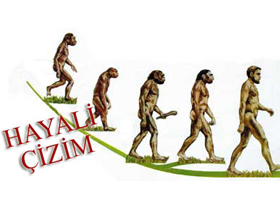The Darwinist claim assumes that modern humans evolved from various ape-like creatures. The assertion is that various transitional forms between modern man and his supposed forbears must have lived during this period, which is assumed to have begun 4 to 5 million years ago. This totally fictitious scenario consists of four basic species:
Evolutionists attach the name Australopithecus, meaning “southern ape,” to the first supposed ape-like ancestors of man. These creatures are in fact an extinct species of ape. There are various types of Australopithecines, some of which are large apes and others of which are smaller and more delicate. (See Australopithecus, the)
In coming up with the series Australopithecines > Homo habilis > Homo erectus > Homo sapiens, evolutionists give the impression that each one is the ancestor of the one succeeding it. Yet the latest paleoanthropological findings show that Australopithecines, Homo habilis and H. erectus all lived in the same period in different regions of the world. Moreover, some humans belonging to the species Homo erectus were living until very modern times and were present in the same surroundings as Homo sapiens neandertalensis and Homo sapiens sapiens (modern man). This, of course, clearly invalidates the claim that these forms are one another’s ancestors.


